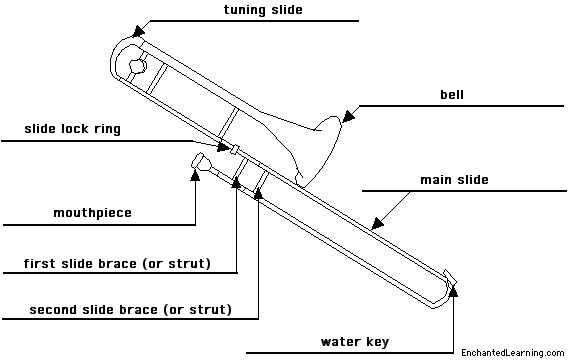First, an apology. I'm sorry I haven't kept up with the posts lately. I've been apartment-hunting, and not only has it taken insane amounts of time, I have also not logged on much these days, to avoid tying up the phone line and thus missing that all-important call from a potential landlord who wants to tell me about his crappy apartment with the windows that don't close and the basement that leaks and the living room that stinks like cat urine. Hooray!
Now, on to better topics. Such as, trombones.

diagram from EnchantedLearning.com
Wikipedia's entry on the Trombone
BBC's edited guide, entry on Trombones
Trombone definitions at Answers.com
Now, on to better topics. Such as, trombones.
diagram from EnchantedLearning.com
- The trombone is a brass instrument, pitched lower than the trumpet and higher than the tuba. The word trombone literally means "big trumpet."
- The trombone's forerunner was called the sackbut. It was slightly smaller than today's trombone and its bell had a more pronounced cone shape. Nobody is positive about the origin of this word, but the speculation is that it is derived from a similar-sounding French word which means "push-pull".
- The trombone as we know it today appeared around the 18th century. It is shaped like a paper clip, with a cup-shaped mouthpiece at one end and a wide bell at the other.
- The trombone has no valves (except for the somewhat rare valve trombone). One changes the note the horn produces by sliding its long, u-shaped lead-pipe farther out, thus lowering the pitch.
- There are seven slide positions which correspond to particular notes. In addition to these positions, trombonists also change the pitch by altering their embrochure; in other words, by tightening or opening their lips against the mouthpiece.
- By the way, the part of the trombone in the above diagram labeled "water key" -- that's a nice way of saying "spit valve." Can't help it with brass instruments but get spit in 'em, and you have to get that spit out.
- It is notoriously difficult to hit the right pitch with this horn, and this is probably why the trombone players in high school bands never seem to know quite what they're doing.
- One newer type of trombone combines the slide as well as valves. These were made in the early 20th century and are sometimes referred to as superbones.
- Unlike the trumpet and the French horn [or horn; see comment], the trombone is uniquely capable among brass instruments of producing a complete chromatic scale. That is, it can hit every note in an octave, not just the whole notes but the sharps & flats (half notes) too.
- The trombone is usually scored as a background or harmonizing instrument, so there are very few trombone solos written, especially in classical music. It has gotten a bit more recognition in marching band, big band, and jazz ensembles, but it is still most often a harmony-provider.
- Folks who are known for their tromboning expertise, and who proved it by playing mad solos on this horn, are Jack Teagarden, J. J. Johnson, and Ray Anderson. Glen Miller, a big band leader from the 1940s, also played trombone, as did Tommy Dorsey.
- If you want to listen to nothing but trombone music, check out Groove Bone internet radio, the Jazz, Latin, and Funk Trombone Show.
Wikipedia's entry on the Trombone
BBC's edited guide, entry on Trombones
Trombone definitions at Answers.com
I realize this is an ancient post, but I can't just let this slide (pun intended! BAZING) - horn and trumpet can absolutely play complete chromatic scales. The trombone differs in that it can play BETWEEN the chromatic notes, which is never/rarely done in western music.
ReplyDeleteAlso, to add to your extensive knowledge base, the instrument "french horn" is rarely used today, having been universally replaced by the "double horn". Horn is the preferred name.
Here I've been thinking "Oh, that French horn player is doing a wonderful job," when all this time I should have been thinking, "Way to go, horn!" I never knew. Thanks for the update.
ReplyDelete